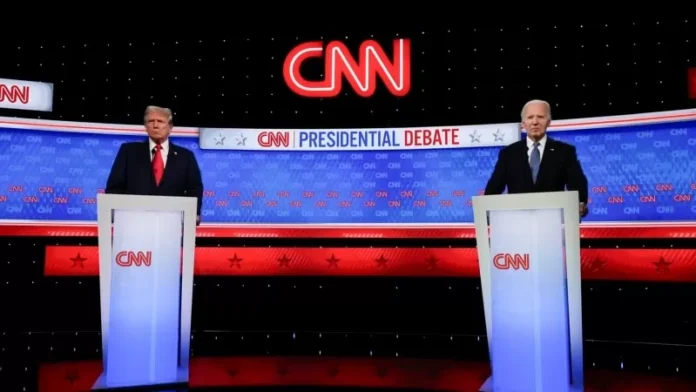New York – The highly anticipated U.S. presidential debate between Democratic President Joe Biden and Republican rival Donald Trump drew in roughly 48 million TV viewers, according to preliminary Nielsen data. While this number may seem impressive, it is actually one-third less than the 73 million people who tuned in to the first face-off between the two candidates in 2020. In fact, this debate ranks among the three lowest-rated first presidential debates since 1976.
This relatively low viewership could be indicative of the current state of voter enthusiasm for both candidates. However, it is important to note that these numbers do not include the full extent of online viewing, which has become increasingly popular as traditional TV audiences decline.
Media experts were eager to see how the new format, presented by host CNN, would play out and whether it would set a precedent for future debates. The restrictions of this format, which included the option for CNN to mute the candidates’ microphones, imposed a level of discipline on the candidates that should be emulated by other networks, according to three media experts.
CNN, which held the exclusive rights to broadcast the debate, allowed candidates two minutes for each answer and one minute for rebuttals. In addition, the network muted their microphones if they exceeded these time limits. The studio also did not have an audience, and moderators Dana Bash and Jake Tapper did not fact-check the candidates in real time.
Some media commentators have criticized CNN for not fact-checking in real time, arguing that it allowed both candidates to spread false claims. However, CNN has defended its decision, stating that the role of the moderators is to present the candidates with important questions and facilitate a debate that allows them to make their case and challenge their opponent.
Despite the lower viewership compared to previous debates, the format of this debate has received positive feedback from media experts. The strict time limits and lack of audience distractions allowed for a more focused and substantive discussion between the candidates.
This debate also marked a significant shift from the chaotic and often chaotic first debate of the 2020 election. The new format, with its emphasis on discipline and structure, provided a much-needed sense of order to the proceedings.
CNN’s decision to mute the candidates’ microphones if they exceeded their allotted time also prevented the debate from devolving into a shouting match, as seen in the first debate. This allowed for a more civil and respectful exchange of ideas between the candidates.
Furthermore, the absence of an audience in the studio also eliminated the potential for biased reactions and interruptions, creating a more level playing field for both candidates.
The role of the moderators in this debate was also crucial. Bash and Tapper asked tough but fair questions, allowing for a lively and informative discussion between the candidates. Their decision not to fact-check in real time also allowed the candidates to present their arguments without constant interruptions.
In conclusion, while the viewership for the second presidential debate may have been lower than expected, the new format presented by CNN has received positive feedback from media experts. This debate has set a precedent for future debates, with its emphasis on discipline, structure, and a more civil and respectful exchange of ideas. The moderators played a crucial role in facilitating a productive discussion between the candidates, and their decision not to fact-check in real time was a wise one. As the election draws closer, it is important for both candidates to continue engaging in meaningful and substantive debates that allow voters to make informed decisions.

